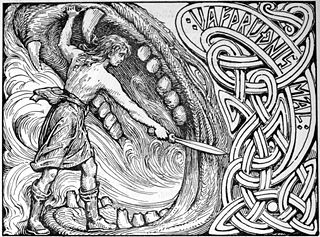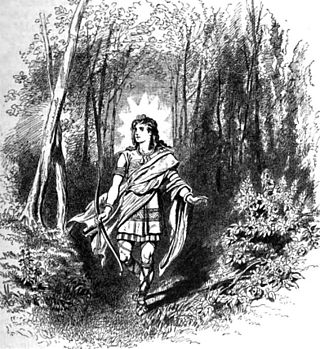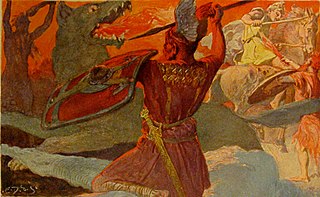
A flaming sword is a sword which is glowing with a flame which is produced by some supernatural power. Flaming swords have existed in legends and myths for thousands of years.

A flaming sword is a sword which is glowing with a flame which is produced by some supernatural power. Flaming swords have existed in legends and myths for thousands of years.
According to the Bible, a flaming sword (Hebrew : להט החרבlahat chereb or literally "flame of the whirling sword" Hebrew : להט החרב המתהפכתlahaṭ haḥereb hammithappeket) was entrusted to the cherubim by God to guard the gates of Paradise after Adam and Eve were banished (Genesis 3:24). [3] [4] [6] Scholars have variously interpreted the sword as a weapon of the cherubim, as lightning, as a metaphor, as an independent divine being, [5] [7] [8] or even as a figurative description of bladed chariot wheels. [9]
In Kabbalah, the flaming sword represents the order which the sefirot were created in, also known as “ the path of the flaming sword.” [10]
Dumah is an angel mentioned in Rabbinical literature and popular in Yiddish folklore. Isaac Bashevis Singer's Short Friday (1964), a collection of stories, mentions Dumah as a "thousand-eyed angel of death, armed with a flaming sword". The sword is otherwise associated with various angels, such as the archangel Uriel, Camael [ citation needed ] or Jophiel. [7] [11]
Eastern Orthodox tradition (as expressed in the Lenten Triodion) says that after Jesus was crucified and resurrected, the flaming sword was removed from the Garden of Eden, making it possible for humanity to re-enter Paradise. [12]
The ancient Gnostic codex On the Origin of the World predicts that the kings under the archons will be drunken from the flaming sword during the end times. [13]
In Norse mythology, the weapon wielded by the giant Surtr is referred to as a "flaming sword" (Old Norse : loganda sverð) by Snorri Sturluson in Gylfaginning 4, of the Prose Edda . [14] [15] [16] Snorri immediately afterwards quotes a stanza from his poetic source, ( Völuspá 52), [17] where it is stated that Surt has fire with him, and that his sword shines with the "sun of the gods of the slain". [15] [16] However, it has been argued that the poem might be stressing the fiery glare of Surtr himself more than the sword. [18] The relevant kenning from the quoted poem, svigi lævi ("destruction of twigs"), is usually interpreted to mean "fire". [lower-alpha 1] [19] [20] [21] However, Henrik Schück interpreted the kenning as referring to a sword, emending the phrase to svigi læva to identify it with the sword Lævateinn in Fjölsvinnsmál . [22] Snorri paraphrases the strophe of the poem a second time in Gylfaginning 51, merely saying: "Surt rides first, and before him and after him is burning fire", [19] [23] afterwards requoting more extensively around the same strophe (Völuspá 48–56). [24] The possibility that this sword imagery was inspired by Christian writings have been speculated. [25]
According to the Welsh triads, the Dyrnwyn ('White-Hilt'), one of the Thirteen Treasures of the Island of Britain, is said to be a powerful sword belonging to Rhydderch Hael, one of the Three Generous Men of Britain. [26] [27] When drawn by a worthy or well-born man, the entire blade would blaze with fire. Rhydderch was never reluctant to hand the weapon to anyone, hence his nickname; Hael (the Generous), but as soon as the recipients learned of its peculiar properties, they always rejected the sword. [26]
The deity Acala (known as Fudō Myōō in Japan) is depicted in Buddhist art holding a sword which may or may not be flaming and sometimes described only generically as a treasure sword (宝剣, hōken) or as a vajra-sword (金剛剣, kongō-ken), as the pommel of the sword is shaped like a talon-like vajra (金剛杵, kongō-sho).
In Hinduism, Kalki (Sanskrit: कल्कि) also called Kalkin or karki, is the prophesied tenth and final incarnation of Hindu God Vishnu to end the Kali Yuga, one of the four periods in the endless cycle of existence (Krita) in Vaishnavism cosmology. The end of Kali Yuga states this will usher in the new epoch of Satya Yuga in the cycle of existence, until the MahaPralaya (the Great Dissolution of the Universe). Kalki is described in the Puranas as the avatar who rejuvenates existence by ending the darkest and destructive period to remove adharma and ushering in the Satya Yuga, while riding a white horse with a fiery sword. The description and details of Kalki are different among various Puranas.
In Vajrayana/Tibetan Buddhism, the flaming sword represents specifically wisdom-piercing-ignosis, and is depicted in the *right* hand of any Buddha in a T'hangka painting, whereas the *left* side of the same Buddha shows the BEing, instead of DOing, e.g. being the meanings of a particular dharma, as symbolized by a flower springing from their left hand, with some particular dharma text being in the open flower, to their left. Take a look at any such thangka ( pronounced t'hangka, but usually in English spelt thangka, which misleads English readers, because it is hard-T-then-H, not TH sound ) painting, and you will see the left-brain/right-body and right-brain/left-body instruction is consistent, and particularly see Manjushri for an example of the flaming-sword-which-pierces-ignosis. It can be represented as a sword made of flame, or as a conventional metal sword with flames about it, either way.

In Norse mythology, Víðarr is a god among the Æsir associated with vengeance. Víðarr is described as the son of Odin and the jötunn Gríðr and is foretold to avenge his father's death by killing the wolf Fenrir at Ragnarök, a conflict he is described as surviving. Víðarr is attested in the Poetic Edda, compiled in the 13th century from earlier traditional sources, the Prose Edda, written in the 13th century by Snorri Sturluson, and is interpreted as depicted with Fenrir on the Gosforth Cross. A number of theories surround the figure, including theories around potential ritual silence and a Proto-Indo-European basis.

The Prose Edda, also known as the Younger Edda, Snorri's Edda or, historically, simply as Edda, is an Old Norse textbook written in Iceland during the early 13th century. The work is often considered to have been to some extent written, or at least compiled, by the Icelandic scholar, lawspeaker, and historian Snorri Sturluson c. 1220. It is considered the fullest and most detailed source for modern knowledge of Norse mythology, the body of myths of the North Germanic peoples, and draws from a wide variety of sources, including versions of poems that survive into today in a collection known as the Poetic Edda.
In Norse mythology, Níðhöggr is a Serpent who gnaws at the roots of the world tree, Yggdrasil. In historical Viking society, níð was a term for a social stigma, implying the loss of honor and the status of a villain. Thus, its name might refer to its role as a horrific monster in its action of chewing the corpses of the inhabitants of Náströnd: those guilty of murder, adultery, and oath-breaking.

In Norse mythology, Váli is a god and the son of the god Odin and the female jötun Rindr. Váli has numerous brothers including Thor, Baldr, and Víðarr. He was born for the sole purpose of avenging Baldr, and does this by killing Höðr, who was an unwitting participant, and binding Loki with the entrails of his son Narfi. Váli grew to full adulthood within one day of his birth, and slew Höðr before going on to Loki. He is prophesied to survive Ragnarök.
Gjálp and Greip are two jötnar in Norse mythology and the daughters of the jötunn Geirröðr. They are killed by the thunder god Thor for trying to kill him.

In Norse mythology, Vígríðr or Óskópnir is a large field foretold to host a battle between the forces of the gods and the forces of Surtr as part of the events of Ragnarök. The field is attested in the Poetic Edda, compiled in the 13th century from earlier traditional material, and in the Prose Edda, written by Snorri Sturluson in the 13th century. The Poetic Edda briefly mentions the field as where the two forces will battle, whereas the Prose Edda features a fuller account, foretelling that it is the location of the future death of several deities before the world is engulfed in flames and reborn.

In Norse mythology, Surtr, also sometimes written Surt in English, is a jötunn; he is the greatest of the fire giants, who serves as the guardian of Muspelheim which is along with Niflheim, the only two realms to exist before the beginning of time. Surtr is attested in the Poetic Edda, compiled in the 13th century from earlier traditional sources, and the Prose Edda, written in the 13th century by Snorri Sturluson. In both sources, Surtr is foretold as being a major figure during the events of Ragnarök; carrying his bright sword, he will go to battle against the Æsir, he will battle the major god Freyr, and afterward the flames that he brings forth will engulf the Earth.
In Norse mythology, Gimlé is a place where the worthy survivors of Ragnarök are foretold to live. It is mentioned in the Prose Edda and the Eddic poem "Völuspá" and described as the most beautiful place in Asgard, more beautiful than the sun.
In Norse mythology, Borr or Burr was the son of Búri. Borr was the husband of Bestla and the father of Odin, Vili and Vé. Borr receives mention in a poem in the Poetic Edda, compiled in the 13th century from earlier traditional material, and in the Prose Edda, composed in the 13th century by Icelander Snorri Sturluson. Scholars have proposed a variety of theories about the figure.

Norse cosmology is the account of the universe and its laws by the ancient North Germanic peoples. The topic encompasses concepts from Norse mythology, such as notations of time and space, cosmogony, personifications, anthropogeny, and eschatology. Like other aspects of Norse mythology, these concepts are primarily recorded from earlier oral sources in the Poetic Edda, a collection of poems compiled in the 13th century, and the Prose Edda, authored by Icelander Snorri Sturluson in the 13th century. Together these sources depict an image of Nine Worlds around a cosmic tree, Yggdrasil.

Eikþyrnir or Eikthyrnir is a stag which stands upon Valhalla in Norse mythology.
In some versions of Norse mythology, Váli was one of the sons of Loki. He is mentioned in the Gylfaginning section of Snorri Sturluson's Prose Edda, chapter 50, possibly by confusion of a reference to Váli, son of Óðinn as binding Loki.
In Norse mythology, Niðafjöll, which means dark mountains, are located in the northern underworld. Niðafjöll is the site from which the dragon Níðhöggr comes. According to Snorri Sturluson, the good and virtuous people will live here in a golden palace after the Ragnarök, despite its proximity to Hel.
In Norse mythology, Sindri is the name of both a dwarf and a hall that will serve as a dwelling place for the souls of the virtuous after the events of Ragnarök. Sindri is also referred to as Eitri, the brother of Brokkr.
Gjöll is the river that separates the living from the dead in Norse mythology. It is one of the eleven rivers traditionally associated with the Élivágar, rivers that existed in Ginnungagap at the beginning of the world.

In Norse mythology, Líf and Lífþrasir, sometimes anglicized as Lif and Lifthrasir, female and male respectively, are two humans who are foretold to survive the events of Ragnarök by hiding in a wood called Hoddmímis holt and, after the flames have abated, to repopulate the newly risen and fertile world. Líf and Lífþrasir are mentioned in the Poetic Edda, which was compiled in the 13th century from earlier traditional sources, and the Prose Edda, written in the 13th century by Snorri Sturluson. Many scholars have speculated as to the underlying meaning and origins of both names.

Litr is the name borne by a dwarf and a jötunn in Norse mythology.

In Norse mythology, Dökkálfar and Ljósálfar are two contrasting types of elves; the dark elves dwell within the earth and have a dark complexion, while the light elves live in Álfheimr, and are "fairer than the sun to look at". The Ljósálfar and the Dökkálfar are attested in the Prose Edda, written in the 13th century by Snorri Sturluson, and in the late Old Norse poem Hrafnagaldr Óðins. Scholars have produced theories about the origin and implications of the dualistic concept.
These are family trees of the Norse gods showing kin relations among gods and other beings in Nordic mythology. Each family tree gives an example of relations according to principally Eddic material however precise links vary between sources. In addition, some beings are identified by some sources and scholars.